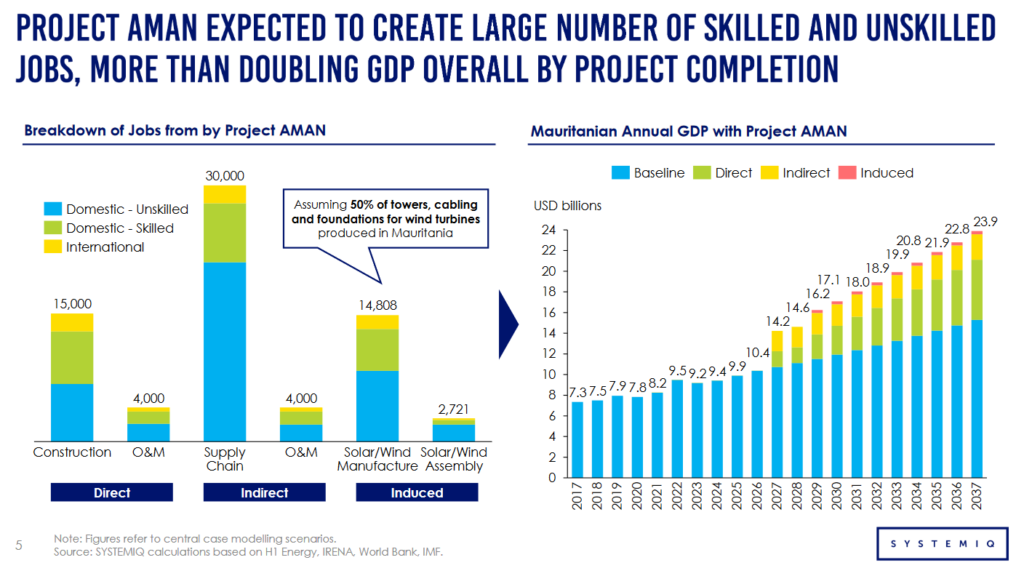Gigawatt-scale renewable ammonia in Northwest Africa
By Kevin Rouwenhorst on November 24, 2022
The November episode of Ammonia Project Features webinar series focused on renewable ammonia production in Northwest Africa, and the socio-economic aspects of planned projects. Nouri Chahid (CWP Global) presented the AMUN (Morocco) and AMAN (Mauritania) projects, while Lloyd Pinnell (Systemiq) explored effects on the local population. The recording is publicly available via our Vimeo channel, and you can also download the speaker presentations.
AMUN & AMAN

CWP Global is a renewable energy developer, with realized solar and wind projects in the hundreds of MW size range. It aims to scale-up solar and wind projects to the GW-scale for renewable ammonia production, for example in the Asian Renewable Energy Hub (AREH). CWP Global is also developing GW-scale projects in Northwest Africa. It plans to deploy 15 GW of wind & solar in Morocco (the AMUN project), and 30 GW of wind & solar in Mauritania (the AMAN project).
The AMUN project will be located close to the city Tan Tan in Morocco, about 100 km along the coast and about 20 to 30 km inland. The project will be deployed in three distinctive phases, with the first two phases having both 3 GW of solar and 3 GW of wind, as well as 2 to 2.5 million tonnes per year of ammonia production. The third phase is still in early development.

The AMAN project is planned about 150 km along the coast, 60 km inland. It will be developed in various phases, e.g. at least two phases. The first phase is expected to be completed in 2029, with the second phase commencing in 2032 or 2033. In terms of hydrogen production cost, Systemiq expects that Mauritania can produce hydrogen at a cost as low as 1.6-2.0 USD per kilogram, which is very competitive globally.
The local context
Renewable ammonia projects require a social license to operate. Thus, the AMAN project does not only focus on renewable ammonia production for export to global commodity markets. Projects like these can be transformative for the local economy. To put the scale into perspective: the AMAN project will generate 110 TWh of power on an annual basis, whereas the current annual power production in Mauritania is just above 1 TWh.
Access to potable water, electricity, and other forms of energy is a challenge in Mauritania. Therefore, projects such as AMAN can aid local communities. The project will deliver 50 to 150 million cubic meters of water to the local population on an annual basis, at a cost as low as 0.60 to 0.80 USD per cubic meter. Furthermore, electricity is provided at a lower cost from the renewables of the AMAN project as compared to current electricity generation in Mauritania.
“Institution building”
Systemiq partners with businesses, finance, policy makers, and civil society to achieve sustainable and equitable redesign of markets and value chains. In this light, it has studied how GW-scale renewables in the AMAN project can aid the social-economic development of Mauritania.
A significant portion of the Mauritanian economy currently revolves around the export of raw extractives such as iron ore, without significant local refining or processing. This means the economy heavily depends on global commodity prices, making the economy vulnerable. Projects such as AMAN can provide the local iron industry with renewable hydrogen, allowing for further processing to value added products.
It should be noted that newfound economic development in a single new market, e.g. ammonia export, also has risks for the overall economy. By increased trade of a single commodity, the value of a local currency can increase, thereby making it hard for other sectors to compete in the global market (a phenomenon known as the “Dutch disease”). Thus, institution building is important, and should be started in the early stages of project development.
Institutions should be established upfront for revenue management & strategy, and a structure should be established to manage trade flows over time without negative impacts on the economy. Lessons can be learned from success stories and failures from the oil & gas industry and mining industry.
Local government is required from the outset, as this allows institution building to start. Furthermore, it leads to a better understanding of the needs for the local population, and how these can be trained as workers for the projects. Lastly, local parties are required to establish the area where the project can be developed.
Local job generation

Next to economic development on a macroeconomic level, sustained job generation is another key aspect of the AMAN project. Most of the jobs generated during construction will be in Mauritania, both unskilled jobs and skilled jobs. About 19,000 direct jobs are expected, of which 4,000 jobs are sustained throughout the lifetime of the plant for operations & maintenance, again mostly local jobs. Including indirect and induced jobs, a total of 70,529 jobs are expected to be generated.
Education is key to make the AMAN project successful. For unskilled jobs such as digging, onsite training will suffice. For skilled jobs, further training is required. This can either be done through: (1) establishing local training institutions tailored to the project needs and the local context, or (2) by exchange programs to outside Mauritania. An existing École Supérieure Polytechnique de Nouakchott in Mauritania already educates future engineers, of which some may find employment for the AMAN project. Within Northwest Africa, more facilities exist. For example, the Noor solar PV park in Morocco has a training facility for renewable energy engineers. Furthermore, Université Mohammed VI Polytechnique in Ben Guerir, Morocco, will soon have a renewable ammonia demonstration & training plant, which allows engineering students to get training before moving to large-scale ammonia synthesis.
To sum up the key messages for project developers, GW-scale renewable ammonia projects can be transformative for local communities, if done correctly. Local communities should benefit, institution building needs to start from the outset, and the techno-economics should work for all stakeholders involved in the project.